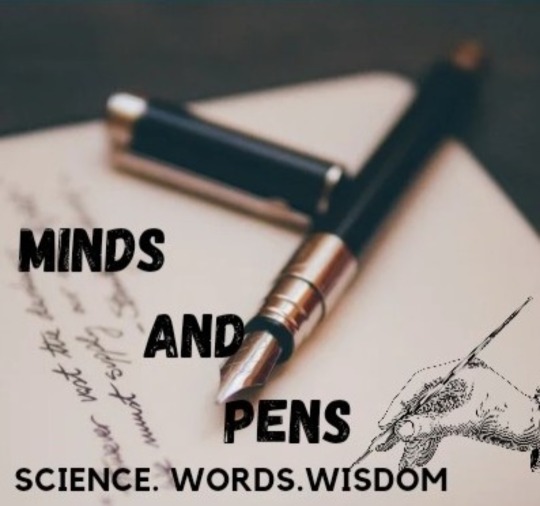#Knowledge sharing
Text
Behind the Scenes with The Solarpunk Conference Organizers
In 2023, the inaugural Solarpunk Conference was held in virtual space, bringing together over 150 attendees, 18 presenters, and creating a palpable sense of the solarpunk community. This episode, Ariel chats with conference organizers Charles Valsechi, Lindsay Jane, and Kees Schuller about the genesis of the conference, the inspiration for its theme, as well as a little preview of what they are hoping to see at the 2024 Solarpunk Conference: Rays of Resilience.
You can go to https://www.solarpunkconference.com/ to check out The Solarpunk Conference, access The Solarpunk Conference Journal, and buy tickets. You can also check out the channel on YouTube for recordings of last year’s presentations, and stop by Lindsay Jane's channel @TheSolarpunkScene for more solarpunky content!
#The Solarpunk Conference#conferences#collective community#online conferences#solarpunk community#knowledge sharing
7 notes
·
View notes
Text
my love language is spamming quotes. you feel bad? i'll find quotes to cheer you up. you have nothing to talk about? it's ok we can interpret a quote. you need motivation? i probably have the perfect quote for that!!!!
#love languages#quotes#dark academia#knowledge sharing#reading#helping#friends#people#bonds#motivation#conversation
12 notes
·
View notes
Text
The US library system, once the best in the world, faces death by a thousand cuts
In addition to political censorship and budget cuts, libraries are being undermined by rapacious digital licensing agreements
by Brewster Kahle

The US library system, once the model for the world, is under assault from politicians, rightwing activists and corporate publishers. Book bans are at record levels, and libraries across the country are facing catastrophic budget cuts, a fate only narrowly avoided by New York City’s public libraries this summer. In a separate line of attack, library collections are being squeezed by draconian licensing deals, and even sued to stop lending digitized books.
This war on libraries – and on the traditional values of equal opportunity, universal education and cultural preservation they represent – directly contravenes the will of the majority in the United States. Polls reveal that public support for libraries is as strong as ever. But the profession of librarianship has become a hazardous one, because of the actions of a hostile minority. It’s time to reverse course.
Centuries ago, publishers, lawmakers and business leaders understood the value to society of libraries, and of making books accessible to anyone curious enough to read them. Mindful of a long history of autocratic tyranny over the dissemination of books, Benjamin Franklin – a publisher and printer by trade – started the first subscription library in the US to spread knowledge widely.
READ MORE
17 notes
·
View notes
Note
I love learning things about characters I didn’t know and not just canon stuff but history of publishing and what goes behind the scenes with editorial. Originally Barbara was created for the the tv show to replace the love interest role for Catwoman. They had casted Eartha Kitt as the new Catwoman and since segregation was still happening in certain parts of the country they wanted to cast a white woman to play a love interest so their show could continue to be played in certain states. Catwoman went from love interest to a more villainous role and Barbara was introduced. Instead of being Bruce’s love interest she set herself apart and really shinned on her own to the point that she ended not as the love interest but and icon in her own right. When they made the move to comics there were still comics that paired her with Bruce (they are married in one of them) and in another she briefly dated Clark Kent. She was given a couple of backups and was the reason comics started using The Batfamily. Before she was introduced, Jim Gordon had a son who accompanied him but he was written out. Another son existed that was an older brother to Barbara but was written out as well. Later a younger brother would be added but he comes and goes given the continuity.
Ohhh! I didn't know that's why she was created I was aware that originally in the comics she was Commissioner Gordons niece, whom he adopted. And that her brother James Gordon Jr in a serial killer, which is very interesting.
Im loving hearing all this Barbara history! I mostly focus on her post injury. As I relate to get heavily as a wheelchair user. But that means I've never really dove into her before than so all this bee info is awesome, truly it is just great!
#Sunnycanwrite#Hehe#Learning so much#Anc loving it#knowledge sharing#batman#batfam#batfamily#dc comics#batgirl#batman and robin#babs#oracle barbara gordon#barbara gordon oracle#barbara gordon#jim gordon#james gordon jr#babs gordon
14 notes
·
View notes
Text
Being emotionally abused more than once can create emotional barriers within your next relationship…. I feel SUPER disconnected from my spouse and have for years but I’ve told myself that it’s not forever and that going back to my ex Andrew (if he would even want me) would be a huge mistake! I’m super uncomfortable and feeling 0 romance but I’m not giving up!! I’m tired of comparing my spouse to my exes. I’m tired of overthinking everything in my marriage. Lately I have not actively worked to make it better. I’ve been “stuck” but I’m just tired… I want my new man to notice where we’re at and to want to change. When you’ve been neglected and used in all your past relationships, you just don’t have the energy to keep giving and giving. I need my new man to start making moves on me 🥺❤️🩹
#emotional abuse#my story#unpacking#healingjourney#online relationships#self awareness#healing from trauma#narcissistic abuse#healing from abuse#tired#mental health#emotional wounds#emotional barriers#Knowledge sharing#this helps#truth#writers on tumblr#writing#writers and poets
2 notes
·
View notes
Text
Hello Tumblr! This is Minds and Pens.
Are you a curious person? Do you often wonder what is going on around you? If yes, then behold Minds and Pens!

But what is Minds and Pens? Well, to put it simply, it's an initiative with the sole aim of sharing knowledge. We do this by making explainer videos covering a diverse range of topics, making documentaries, writing blogposts, and podcasting. All our posts are created after meticulous research so that they are knowledgeable, satisfy your curiosity, and help you make a better sense of the world around you. All in all, Minds and Pens is an initiative for the curious minds.
The initiative includes a YouTube channel, namely Venture Beyond and a Podcast, namely The Knowledge Nexus and a blog for now. The explainer videos and the documentaries are uploaded on the YouTube channel. For example, two miniseries on Artificial Intelligence and the USA-Iran conflict are currently live on the YouTube Channel. To watch Click here!
The tagine of the initiative is "Science. Words Wisdom". Which effectively conveys the values around which Minds and Pens is built.
Interested much!! Join us on this journey of learning by following our blog on Tumblr. Additionally, you can connect with us on Facebook, Instagram, and 𝕏 by clicking on the links below:
Facebook
Instagram
𝕏 (formerly known as Twitter)
#new blog#Tumblr#educate yourself#curious#curiousity#youtube#science#Words#Wisdom#knowledge sharing#explainer videos#research-driven#podcasting#educational content#learn with us#artificial intelligence#Global Issues#Social Impact
6 notes
·
View notes
Quote
These institutions must grapple with their legacies of intellectual and cultural abuse towards Indigenous peoples and emerging industry norms that increasingly demand respect for Indigenous rights, while continuing to make knowledge resources available and accessible to the public, to the extent allowed by law. Faced with these two seemingly incommensurable objectives, many institutions have begun to adopt cumbersome, generally unenforceable internal policies and procedures that tend to limit access to Indigenous culture as a remedy for past abuses rather than looking to Indigenous communities for guidance on methods for repair and redress. This Article advocates for a different approach - one which merges restorative justice theory and well-established methods for “Open Source” or “Creative Commons”-style licensing into what I call restorative licensing. I further advocate for the integration of privately ordered licensing structures within the restorative justice process to ensure Indigenous expectations for repair and redress are met, and that Indigenous cultural expressions can circulate once again on terms consistent with Indigenous law, protocol, and standards of care.
Trevor Reed from the Abstract to Restorative Justice for Indigenous Culture by way of Turtle Talk. Trevor Reed on Restorative Justice for Indigenous Culture
15 notes
·
View notes
Text
musings on things; an attempt to commodify myself so i could finally fit in with society's standards of productivity
this came to me in a dream... jk my brain went berserk.
it's important to have a second-brain notebook for my random epiphanies, lightbulb moments. my adhd brain cannot handle just trusting my brain to remember it for when i need that info.
besides, it'll help improve retention and recall, combat information overload, and support knowledge sharing.
it apparently takes 30 minutes to get in the "zone". it needs to be uninterrupted. and efficient, productive work can only be good for four to five hours a day, so we have to stretch it. how?
prioritize. categorize (sync or async?)
identify roles per day. what are we today? the maker or the manager?
time box. stick to it. announce for accountability and to be off limits.
weekly resets are important.
rewards are also important. i need to make a list of rewards and play i can look at when i want to take a break. the break shall not involve social media. socializing, yes, but not social media.
planning a task needs a lot of things, at least for my pea-sized brain:
the task, of course.
deadline
dependencies
breakdown -> milestones
how much effort is needed/weight
importance, impact (related to dependencies)
an Eisenhower matrix is helpful
a reflection is like a project status report. it may or may not need the following:
project name (oplan kim's brain needs help. and jesus. jesus' help.)
period
decide when to reflect and then adapt. weekly and monthly maybe. the daily could just be a brain dump instead.
timeline
scope
categories. what parts and aspects of your life this reflection covers. focus!
status
achievements
important metrics
blockers
action items/next steps
praise/shoutouts/gratitude
stakeholders
identify who this is for.
just gonna emphasize the four to five hour timeframe for productivity. practice. protect it.
maybe try pomodoro with larger chunks. once into a state of deep work, ignore the timer. or have a shorter break.
in time blocking, schedule buffers.
track productivity.
when were you creative today? when did you get creative?
try to find a new environment when you're starting to get restless.
for habitats, no failing two days in a row. do it even if half assed.
i think that's it. get out of my brain.
3 notes
·
View notes
Text
RTMP- Roles of workers' organizations in implementing the commitments under the regional frameworks on forced labour and child labour.
This panel discussion will focus on how these organizations can effectively implement the commitments outlined in regional frameworks to protect vulnerable populations. Attendees will learn about successful strategies and practical measures that workers' organizations have adopted to enforce labour standards and advocate for ethical practices.
Watch RTMP- Roles of workers' organizations in implementing the commitments under the regional frameworks on forced labour and child labour!

#panel discussion#ngos#private sector#stakeholders#workers' organizations#laborers#advocacy#ethical practices#commitments#suscessful strategies#practical measures#forced labor#child labor#knowledge sharing#african countries#policy changes#accountability
0 notes
Text
Enhancing Employee Performance with Microlearning: A Deep Dive into the 70:20:10 Model

In today's fast-paced work environment, traditional training methods often fall short in equipping employees with the necessary skills and knowledge to excel in their roles. Microlearning has emerged as an effective strategy to bridge this gap, offering on-the-job support and significantly enhancing employee performance. By delivering bite-sized, focused learning modules, microlearning aligns perfectly with the principles of the 70:20:10 model of learning and development. This model asserts that 70% of learning occurs through workplace experiences, 20% through social learning, and 10% via formal structured learning. Let’s explore how microlearning integrates with this model to optimize employee development.
The 70:20:10 Model: A Brief Overview
The 70:20:10 model, developed by Morgan McCall, Michael M. Lombardo, and Robert A. Eichinger at the Center for Creative Leadership, provides a robust framework for understanding how adults learn in professional settings. The model suggests that:
70% of learning comes from on-the-job experiences: This involves solving real-life problems, taking on challenging tasks, and gaining practical insights through daily activities.
20% of learning is derived from social interactions: This encompasses mentoring, coaching, collaboration, and learning through observation and feedback from peers and leaders.
10% of learning is from formal education: This includes structured courses, workshops, and training programs designed to impart specific knowledge and skills.
Microlearning and On-the-Job Experiences (70%)
Microlearning is inherently practical, making it an ideal tool for facilitating on-the-job learning. Here’s how it aligns with the 70% component of the model:
Immediate Application: Microlearning modules are typically concise and focused on specific skills or knowledge areas, allowing employees to quickly apply what they’ve learned to their work. This immediacy reinforces learning through real-world application, which is critical for retention and mastery.
Contextual Relevance: By delivering content that is directly relevant to an employee's daily tasks, microlearning ensures that the training is pertinent and immediately useful. For instance, a sales associate might receive a quick lesson on handling customer objections just before a client meeting.
Flexibility: Microlearning can be accessed anytime, anywhere, enabling employees to learn at the point of need. This flexibility ensures that learning doesn’t disrupt work but rather complements it, fitting seamlessly into the flow of the workday.
Microlearning and Social Learning (20%)
Microlearning also plays a significant role in facilitating social learning, the 20% aspect of the 70:20:10 model. Here’s how:
Collaborative Learning: Microlearning platforms often include features that encourage interaction, such as discussion forums, social media integration, and peer reviews. These features foster a collaborative learning environment where employees can share insights and best practices.
Mentorship and Coaching: Short, targeted learning modules can be used by mentors and coaches to support their guidance. For example, a mentor might assign a specific microlearning module to address a mentee’s area of improvement and then discuss the content in a follow-up session.
Feedback Mechanisms: Microlearning tools often incorporate feedback systems where learners can receive immediate input on their performance. This continuous feedback loop helps learners refine their skills and knowledge through social interaction.
Microlearning and Formal Education (10%)
While microlearning shines in practical and social contexts, it also complements formal structured learning, the 10% of the 70:20:10 model:
Reinforcement of Formal Training: Microlearning can be used to reinforce and supplement formal training sessions. After attending a workshop or a course, employees can engage with microlearning modules that reinforce key concepts and provide additional practice opportunities.
Pre-Training Preparation: Short modules can be used to prepare employees for formal training sessions, ensuring they have the foundational knowledge needed to maximize the benefits of the course.
Post-Training Follow-Up: Following formal training, microlearning can offer follow-up modules that help solidify the learning, address any lingering questions, and provide ongoing support.
Benefits of Microlearning in the 70:20:10 Framework
Increased Engagement: Microlearning’s bite-sized format is more engaging than traditional lengthy courses. Employees are more likely to complete and retain the information presented in short, focused bursts.
Higher Retention Rates: Research shows that spaced repetition and short learning sessions significantly improve information retention. Microlearning leverages these principles, helping employees remember and apply what they’ve learned.
Personalized Learning Paths: Microlearning allows for the creation of personalized learning experiences. Employees can choose modules that address their specific needs and learning preferences, fostering a more tailored and effective learning experience.
Cost-Effective: Microlearning is typically more cost-effective than traditional training programs. It requires fewer resources to develop and deliver and can be scaled easily across the organization.
Implementing Microlearning: Best Practices
To maximize the benefits of microlearning within the 70:20:10 framework, organizations should consider the following best practices:
Identify Key Learning Objectives: Start by identifying the specific skills and knowledge areas that need to be addressed. This ensures that each microlearning module is purposeful and aligned with organizational goals.
Leverage Technology: Utilize modern learning management systems (LMS) and mobile learning platforms to deliver microlearning content. These tools provide easy access, track progress, and offer analytics to measure effectiveness.
Integrate with Workflows: Ensure that microlearning is seamlessly integrated into the daily workflows of employees. This can be achieved by making content accessible through mobile devices, enabling learning at the point of need.
Encourage Social Learning: Foster a culture of collaboration and knowledge sharing. Encourage employees to discuss and share microlearning content, participate in forums, and provide peer feedback.
Continuous Improvement: Regularly review and update microlearning content to ensure it remains relevant and effective. Gather feedback from employees to identify areas for improvement and to keep the learning experience fresh and engaging.
Conclusion
Microlearning, with its focus on delivering concise and relevant content, fits seamlessly within the 70:20:10 learning and development model. By supporting on-the-job learning, facilitating social interactions, and complementing formal education, microlearning not only enhances employee performance but also fosters a culture of continuous improvement. As organizations continue to navigate the complexities of the modern workplace, microlearning offers a dynamic and effective solution to meet their evolving learning needs.
#Microlearning#Employee Performance#On-the-Job Support#70:20:10 Model#Workplace Learning#Informal Learning#Social Learning#Formal Structured Learning#Learning and Development#Continuous Improvement#Bite-Sized Learning#Practical Training#Real-World Application#Flexible Learning#Collaborative Learning#Mentorship and Coaching#Feedback Mechanisms#Learning Engagement#Information Retention#Personalized Learning Paths#Cost-Effective Training#Learning Management Systems (LMS)#Mobile Learning Platforms#Seamless Integration#Knowledge Sharing#Peer Feedback#Learning Objectives#Technology in Learning#Training Effectiveness#Modern Workplace Training
0 notes
Text
My Knowledge Journey: May, 2024
Explore the transformative power of adopting the role of an archivist in blogging. Forget perfection and focus on sharing knowledge. From geopolitics to self-improvement, blending topics can create engaging content.
To be honest, I didn’t learn anything on a technical level. However, when it comes to mental and systemic aspects,
My Knowledge Journey: May, 2024
Embracing the Role of an Archivist in Blogging: A Journey of Self-Discovery and Expression
Key Takeaways:
Forget Perfection: Blogging doesn’t need to be perfect, and you don’t need to be an expert. Just focus on sharing what you learn.
Think Like…

View On WordPress
#Archivist Mindset#Audience Engagement#Blogging Journey#Blogging Strategy#Blogging Tips#Content Organization#Cultural Shifts#Curating Content#Generational Knowledge#Geopolitics Insight#Historical Lessons#Knowledge Sharing#Learning And Sharing#Mindset Shift#Overcoming Perfectionism#personal growth#Scribe Of Knowledge#Self Discovery#Self Improvement#Stress Reduction
0 notes
Text
Harnessing Artificial Intelligence for Sustainable Development Goals (SDGs) - Economic and Social Council, Special meeting.
Opening remarks by Amina J. Mohammed, Deputy Secretary-General of the United Nations.
The objectives of the Special Meeting are to:
Examine the role of governance frameworks in guiding the ethical and responsible deployment of AI technologies to support the achievement of the SDGs;
Showcase real-life examples and case studies illustrating how AI has been utilized to address specific SDGs, highlighting successes, challenges, and lessons learned; and
Facilitate knowledge sharing, collaboration, and partnerships among stakeholders from governments, international organizations, academia, civil society, the private sector, technical standards organizations, and AI experts in leveraging AI for sustainable development.
The Special Meeting will bring together diverse stakeholders from governments, international organizations, academia, civil society, the private sector, technical standards organizations and AI experts to foster dialogue, collaboration and knowledge sharing on leveraging AI for sustainable development.
Watch the Harnessing Artificial Intelligence for Sustainable Development Goals (SDGs) - Economic and Social Council, Special meeting.

#eruptive technologies#disruptive technology#artificial intelligence#sustainable development#sustainable development strategies#ecosoc#united nations economic and social council#meeting#knowledge sharing#AI experts#ai technology#United Nations Trusteeship Council#agenda 2030#globalgoals#sustainable development goals#member states
0 notes
Text
Groundwater use without proper knowledge jeopardizes sustainable water sources in the long term.

The SADC/GMIC project (phase II), co-financed by CIWA program, is advancing transboundary groundwater cooperation and management. Explore the project's impact on sustainable practices.
#water#groundwater#boundary waters#water cooperation#sustainable water management#CIWA#World Bank Group#water resources#sdg6#knowledge sharing
0 notes
Text

Empower Your Mentorship Program with Mentorloop Services
#Mentorship#Professional development#Networking#Career growth#Skill enhancement#Guidance#Coaching#Talent development#Learning opportunities#Career advancement#Supportive community#Knowledge sharing#Mentoring programs#Mentor matching#Skill building
0 notes
Text
Healing from Emotional Abuse: Understanding the Impact and Nurturing Your Recovery (A.I. Based)
Introduction:
As an AI-based post aimed at sharing knowledge and fostering healing for all individuals who have experienced emotional abuse, it is essential to delve into the lasting impact of such trauma, strategies to process it, and ways to prioritize self-care during the healing journey. While this narrative is not reflective of any specific individual, it resonates with the shared experiences of many who have navigated abusive relationships. In this context, let's explore the effects of emotional abuse and the steps towards healing and self-nurturing.
The Impact of Emotional Abuse:
Emotional abuse can leave deep scars on one's mental and emotional well-being, affecting self-esteem, trust, and overall sense of self. The experiences of being emotionally manipulated, belittled, or controlled can linger long after the relationships have ended. In the case of our fictional narrative(about me ruminate88), the encounters with Jake, Cody, and Andrew highlight varied forms of emotional abuse — from subtle manipulation to outright ghosting. It is crucial to acknowledge that emotional abuse can occur in different shapes and sizes, often leaving individuals feeling invalidated, anxious, and unworthy of love.
Ways to Process Emotional Abuse:
Processing emotional abuse involves acknowledging the pain, unraveling the patterns of toxic behavior, and reclaiming your sense of self-worth. Therapy, journaling, creative expression, and mindfulness practices are effective tools for unpacking the trauma, gaining insights into the dynamics of abusive relationships, and fostering healing. Reflecting on the experiences with Jake, Cody, and Andrew can provide opportunities for growth, self-awareness, and empowerment. By recognizing the red flags, setting boundaries, and seeking support, individuals can begin to untangle the web of emotional abuse and move towards healing.
Taking Care of Yourself During the Healing Process:
Self-care plays a pivotal role in the journey towards healing from emotional abuse. It involves treating yourself with compassion, practicing self-love, and prioritizing your well-being. Engaging in activities that bring you joy, surrounding yourself with supportive individuals, and honoring your emotions are essential components of self-nurturing. While healing may be a nonlinear process with its ups and downs, embracing self-care practices can create a safe space for emotional processing and growth.
Conclusion:
In conclusion, the journey of healing from emotional abuse is a profound and transformative experience that requires courage, self-compassion, and perseverance. By acknowledging the impact of past traumas, actively working towards processing them, and nurturing oneself through self-care practices, individuals can pave the way for healing and personal growth. Remember, you deserve to be treated with respect, kindness, and love — and your healing journey is a testament to your inner strength and resilience. Let this AI-based post serve as a source of knowledge, empowerment, and comfort for all those on their path to healing from emotional abuse.
#ai generated#emotional abuse#my story#unpacking#healingjourney#online relationships#heartbreak#self awareness#self healing#narcissistic abuse#narcissism#manipulation tactics#manipulation#healing from trauma#mental health#healing from abuse#toxic relationship#toxic love#toxic people#knowledge sharing#knowledge#this helps#healing journal#healing journey#healing takes time#encouragment#writers on tumblr#writers and poets#real life#life lessons
4 notes
·
View notes
Text
My article on "India's first crewed space mission - Gaganyaan" in Gujarati, has been published on the reflection website.
Read here - https://reflections.live/articles/788/gaganyaan-bharatanum-sauprathama-samanava-avakasa-udana-mission-article-by-vishakha-mothiya-14770-ltxwlqtf.html

#writer#generalknowledge#articlewriting#mustread#isroindia#isromissions#gaganyaan#crewed space mission#human flight mission#space science#just know#knowledge sharing#gujarati writer#informative
0 notes